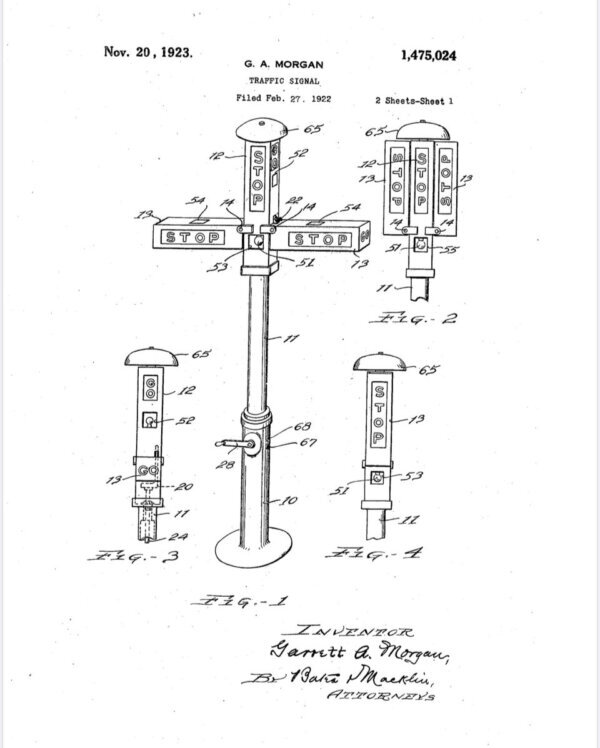Some aggressive driving behaviors never change — even as technology has morphed from mechanical to electronic, to computer-driven.
Next week marks 100 years since Garrett Morgan was granted a patent for his improved traffic signal, the first signal that contained a step between “stop” and “go” — a cautionary period, in which traffic is stopped in all four directions.
Morgan invented what has come to be known as “the yellow light.”
And, in his Nov. 20, 1923, patent granted by the U.S. Patent and Trademark Office, Morgan cited one reason for the invention was to alleviate a driver behavior that’s still prevalent in 2023 — drivers honking when a light turns green.
“In the 1920s, vehicular traffic was just emerging as something that was achievable by middle-class Americans, not just the elite,” said Rebekah Oakes, historian for the USPTO.
At the time, without standard infrastructure, traffic was often chaotic, in part because most drivers were inexperienced.
“Cars, trucks, commercial vehicles were all sharing the road with horse-drawn buggies, pedestrians and they were sharing the road with streetcars in a lot of major cities,” Oakes said.
In the early 1920s, Morgan, a Black man from Cleveland, was driving with his two sons in the car: “They witnessed a really horrific accident between a car and a horse-drawn buggy,” said Oakes, resulting in young girl being thrown from the buggy, and an injured horse being humanely euthanized in the street.

“That really affected him,” Oakes said. “So, he designed, invented, and patented a traffic signal that would be more prominent in the street,” and that could be operated by a police officer tasked with directing traffic.
The traffic signal Morgan invented “looked like a T-shape, and it had arms you could move in different directions that would indicate ‘stop’ or ‘go,’ and it was powered by a hand crank.”
However, what separated Morgan’s device from others was a sequence, in which by design, all cars would remain clear of the intersection.
“Between ‘stop’ and ‘go’ there would be another option: ‘clear the intersection,’ before traffic resumed moving. Today, we know that as the caution light or yellow light,” Oakes explained.
Why the yellow light was invented
In his patent application, Morgan said his invention would help in “avoiding accidents which frequently occur by reason of the over-anxiety of the waiting drivers to start as the signal to proceed is given.”
“We’re familiar with that today, here in the D.C. area,” laughed Oakes. “If you don’t go when the light turns green, you’re going to get honked at.”
Now, as it was 100 years ago, the yellow light served a safety purpose: “When people went, immediately upon getting that ‘go’ signal, there might have still been a vehicle or even a pedestrian in that intersection — and that’s how a lot of those accidents occurred.”
Morgan’s traffic signal was invented in a time of transition.
“Electricity wasn’t necessarily something that was on every city street at that point — so the mechanical traffic signal, with the crank, provided a little more flexibility,” she said.
Oakes said in the 1920s, public demonstrations of new products were important to tempt prospective customers. Morgan installed his first traffic signal in Willoughby, Ohio — a more rural community than Cleveland that still had a large enough intersection to demonstrate the invention’s necessity.
“General Electric was very interested in his technology,” Oakes said. “They were looking to create both mechanized and electric traffic signals, but they wanted to basically scoop up the rights to as many patents as possible, as they were figuring out how they wanted to move forward.”
GE purchased the rights to Morgan’s patent for $40,000: “That was a significant amount of money in 1923 dollars,” Oakes said.
Morgan’s patented mechanized signal never went into widespread production: “However, the idea of that caution light went forward into what we eventually know as electric traffic signals today,” Oakes said.
Morgan had previously been granted a patent for a smoke hood, with a hanging air tube, which enabled firefighters to enter a smoke-filled space for a period of time.
He died after a long battle with an illness in Cleveland in July 1963.
Morgan’s original traffic signal prototype is on display at the Smithsonian’s American History Museum in D.C.





